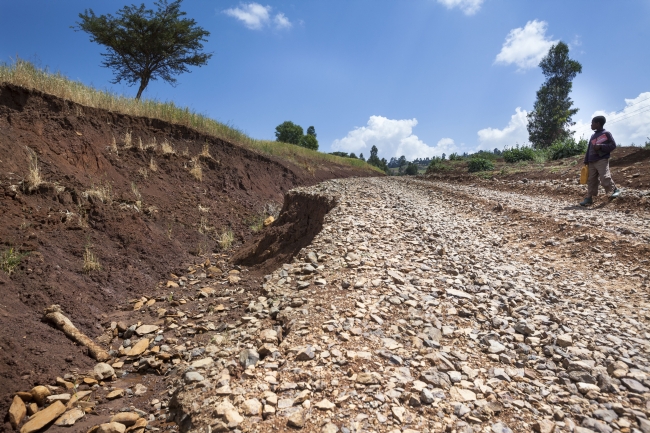Ethiopia’s farmers pay a high price for soil erosion
In a country of steep valleys and heavy seasonal rains, soil loss is a persistent threat. But just how much does erosion cost farmers? A new study suggests that for some Ethiopian smallholders, it may represent as much as half of their annual income.

Photo: Petterik Wiggers / IWMI
Farming in much of rural Ethiopia is a precarious business. Whilst a wide variety of climatic conditions and land types mean that many crops can be grown, the reality is that smallholder farmers have little opportunity to develop their plots. Poverty and lack of infrastructure are at the root of much of the problem, but a capricious climate and fragile landscape compound the issue. Soil erosion is a constant and widespread threat. Together with nutrient depletion, it is estimated that soil loss puts 30,000 hectares of the country’s cropland out of production annually – that’s an area nearly two thirds the size of Addis Ababa. [pullquote type=”pullquote3″ content=”On-farm soil and water conservation measures need to be encouraged” quote_icon=”yes” align=”right” textcolor=”#21a12f”]On-farm soil and water conservation measures need to be encouraged[/pullquote]
To find out just how much soil erosion costs Ethiopian farmers, a study team, led by IWMI, looked at three watersheds in the Ethiopian part of the Blue Nile Basin. During the rainy reason, samples of field runoff were collected and assessed for sediment and concentrations of nitrogen and phosphorous. This was then matched to local crop yield.
The results, recently published in the open-access journal Solid Earth, showed a significant reduction in yield for grain and tuber crops. For maize alone, farmers at one site annually lost about USD 220 per hectare due to depleted nitrogen, and USD 150 per hectare for phosphorous. Given that the per capita income for the country is only USD 470, this is a substantial amount of money.
And crops aren’t just grown for the table. Crop residues, for instance, can be fed to cattle, so actual losses to the farmer may be even greater.
It’s a huge cost, so what is the solution?
“On-farm soil and water conservation measures need to be encouraged,” says IWMI’s Teklu Erkossa, one of the paper’s authors. “The magnitude of the effect is higher in areas with more fertile soil than those that have experienced severe degradation. This suggests that priority should be given to the ‘high potential’ areas where productivity could be maintained. However, farmers in such areas may be reluctant to take actions since the effect may not be immediately apparent.”
The authors hope that studies like this one will highlight the cost of a “do nothing” approach. By alerting land users and policy makers to the danger, they hope that the payback of conservation measures will become more evident.
“Sometimes it may be necessary to take land out of production for construction of conservation structures but, even this can be cost effective over the long- term,” says Erkossa. “But we also need to establish better ways of assessing how erosion and conservation measures might affect other local people to ensure costs and benefits are fairly shared. That will mean coordination between upstream and downstream land and water users so they can collaboratively manage the landscape.”
This study was financially supported by the CGIAR Research programs on:
[fancy-ul style=”arrow-type3-list” variation=”deepblue”]
[/fancy-ul]

